Blue gularis - Fundulopanchax sjostedti
Scientific name: Fundulopanchax sjostedti
Common name: Blue gularis
Family: Nothobranchiidae
Usual size in fish tanks: 11 - 13 cm (4.33 - 5.12 inch)
014
Recommended pH range: 6 - 7.5
Recommended water hardness: 4 - 18°N (71.43 - 321.43ppm)
0°C 32°F30°C 86°F
Recommended temperature range: 22 - 26 °C (71.6 - 78.8°F)
The way how these fish reproduce: Spawning
Where the species comes from: Africa
Temperament to its own species: aggressive/territorial
Temperament toward other fish species: aggressive/territorial
Usual place in the tank: Middle levels
Food and Feeding
The Blue Gularis (Fundulopanchax sjostedti) thrives on a high-protein diet. Their diet should primarily consist of live or frozen foods such as bloodworms, small crustaceans, and brine shrimp. These foods closely mimic their natural diet and provide the nutrients needed to maintain their vibrant coloration. While they may accept some prepared or dry foods, these should only be supplementary. Feed them twice a day in small portions, ensuring food reaches all areas of the tank as they can be shy feeders.
Origin
The Blue Gularis originates from West Africa, specifically the rivers and streams of Sierra Leone and Western Liberia. These habitats are characterized by soft, slightly acidic to neutral waters with dense vegetation and slow-moving currents. The natural environment features shaded areas with plenty of hiding spots and spawning substrates, which play a crucial role in their behavior and care requirements in captivity. Replicating these conditions in an aquarium is essential for their health and comfort.
Sexing
Sexing Fundulopanchax sjostedti is relatively straightforward. Males are larger, more colorful, and display elaborate fins compared to the smaller, duller females. Males often exhibit aggressive behavior and fin flaring during breeding or territorial disputes, making sex differentiation easier. Females tend to have less vibrant patterns and shorter fins, offering a clear visual distinction.
Breeding
Breeding the Blue Gularis requires careful preparation. Set up a dedicated breeding tank with soft, slightly acidic water and a layer of peat moss at the bottom. During spawning, the female buries the eggs in the peat. To protect the eggs, remove the peat immediately after spawning and store it in damp conditions for incubation. Ensure a ratio of one male to two females, as males can be aggressive. Each spawning produces a small number of eggs, which take approximately 3 weeks to hatch under optimal conditions. Maintain the incubation temperature at 23-25°C (73.4-77°F) and keep the peat slightly damp but not submerged. Adding a small amount of antifungal treatment can reduce the risk of egg fungus.
Lifespan
Fundulopanchax sjostedti are not annual killifish. With proper care, they can live up to 3 years in captivity. Their lifespan can be extended by maintaining pristine water conditions, providing a high-protein diet, and reducing stress through adequate tank space, hiding spots, and compatible tankmates.
Temperament
The Blue Gularis is a highly territorial and aggressive species, both toward its own kind and other fish. Keeping them in a community tank is challenging unless housed with similarly sized, robust species. Providing plenty of visual barriers, such as plants and caves, and keeping only one male per tank can help mitigate aggressive behavior. If aggression persists, consider using a tank divider to separate individuals safely. Their territorial nature makes them best suited for species-only tanks.
Tank Requirements
Blue Gularis prefer tanks with a minimum capacity of 75 liters (~20 gallons) for a single specimen, with more space required for additional individuals. The water should have a temperature of 22-26°C (71.6-78.8°F), a pH range of 6.0-7.5, and a hardness of 4-18°N (71.43-321.43 ppm). Use soft, sandy substrate and decorate the tank with plants such as Java Fern or Anubias, which thrive in similar conditions. Driftwood not only enhances aesthetics but also helps mimic the tannin-rich waters of their native rivers. Moderate lighting and slow water flow are ideal for their comfort.
Short Description
The Blue Gularis (Fundulopanchax sjostedti) is a stunning killifish species known for its dazzling blue and red coloration and elongated fins. Native to West Africa, they are a challenging yet rewarding species for experienced aquarists. While relatively easy to breed, their eggs and fry are prone to fungal infections, requiring diligent care. Their aggressive nature makes them better suited to species-only tanks, where they can thrive without competition. With a lifespan of up to 3 years, they are a captivating centerpiece for well-maintained aquariums.
Picture
Bought by aqua-fish.net from jjphoto.dk.
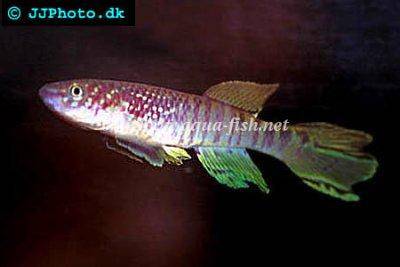

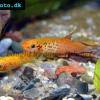 Lyretail
Lyretail  Splendid
Splendid  Redchin
Redchin  Panchax
Panchax 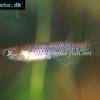 Sixbar
Sixbar  Amiets
Amiets  Blue
Blue 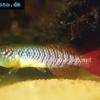 Guenthers
Guenthers 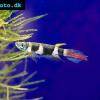 Banded
Banded